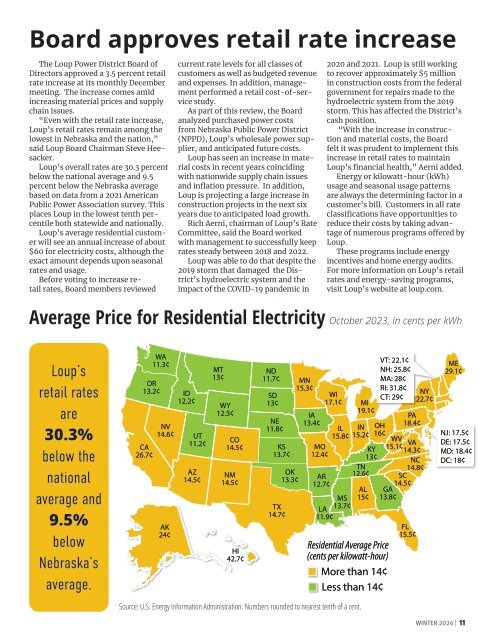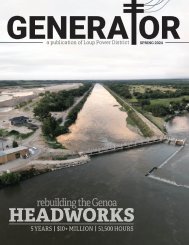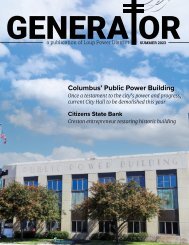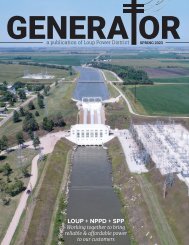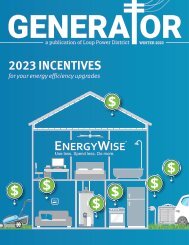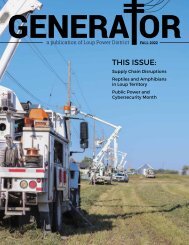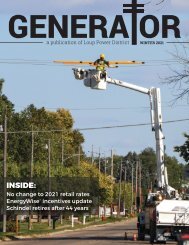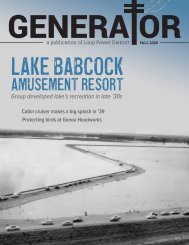Winter 2024 Generator
Topics in this issue include a 2024 rate increase, a lineman's perspective on the power restoration, and 2024 EnergyWise incentives.
Topics in this issue include a 2024 rate increase, a lineman's perspective on the power restoration, and 2024 EnergyWise incentives.
You also want an ePaper? Increase the reach of your titles
YUMPU automatically turns print PDFs into web optimized ePapers that Google loves.
Board approves retail rate increase<br />
The Loup Power District Board of<br />
Directors approved a 3.5 percent retail<br />
rate increase at its monthly December<br />
meeting. The increase comes amid<br />
increasing material prices and supply<br />
chain issues.<br />
“Even with the retail rate increase,<br />
Loup’s retail rates remain among the<br />
lowest in Nebraska and the nation,”<br />
said Loup Board Chairman Steve Heesacker.<br />
Loup’s overall rates are 30.3 percent<br />
below the national average and 9.5<br />
percent below the Nebraska average<br />
based on data from a 2021 American<br />
Public Power Association survey. This<br />
places Loup in the lowest tenth percentile<br />
both statewide and nationally.<br />
Loup’s average residential customer<br />
will see an annual increase of about<br />
$60 for electricity costs, although the<br />
exact amount depends upon seasonal<br />
rates and usage.<br />
Before voting to increase retail<br />
rates, Board members reviewed<br />
current rate levels for all classes of<br />
customers as well as budgeted revenue<br />
and expenses. In addition, management<br />
performed a retail cost-of-service<br />
study.<br />
As part of this review, the Board<br />
analyzed purchased power costs<br />
from Nebraska Public Power District<br />
(NPPD), Loup’s wholesale power supplier,<br />
and anticipated future costs.<br />
Loup has seen an increase in material<br />
costs in recent years coinciding<br />
with nationwide supply chain issues<br />
and inflation pressure. In addition,<br />
Loup is projecting a large increase in<br />
construction projects in the next six<br />
years due to anticipated load growth.<br />
Rich Aerni, chairman of Loup’s Rate<br />
Committee, said the Board worked<br />
with management to successfully keep<br />
rates steady between 2018 and 2022.<br />
Loup was able to do that despite the<br />
2019 storm that damaged the District’s<br />
hydroelectric system and the<br />
impact of the COVID-19 pandemic in<br />
2020 and 2021. Loup is still working<br />
to recover approximately $5 million<br />
in construction costs from the federal<br />
government for repairs made to the<br />
hydroelectric system from the 2019<br />
storm. This has affected the District’s<br />
cash position.<br />
“With the increase in construction<br />
and material costs, the Board<br />
felt it was prudent to implement this<br />
increase in retail rates to maintain<br />
Loup’s financial health,” Aerni added.<br />
Energy or kilowatt-hour (kWh)<br />
usage and seasonal usage patterns<br />
are always the determining factor in a<br />
customer’s bill. Customers in all rate<br />
classifications have opportunities to<br />
reduce their costs by taking advantage<br />
of numerous programs offered by<br />
Loup.<br />
These programs include energy<br />
incentives and home energy audits.<br />
For more information on Loup’s retail<br />
rates and energy-saving programs,<br />
visit Loup’s website at loup.com.<br />
Average Price for Residential Electricity October 2023, in cents per kWh<br />
Loup’s<br />
retail rates<br />
are<br />
30.3%<br />
below the<br />
national<br />
average and<br />
9.5%<br />
below<br />
Nebraska’s<br />
average.<br />
CA<br />
26.7¢<br />
WA<br />
11.3¢<br />
OR<br />
13.2¢<br />
NV<br />
14.6¢<br />
AK<br />
24¢<br />
ID<br />
12.2¢<br />
UT<br />
11.2¢<br />
AZ<br />
14.5¢<br />
MT<br />
13¢<br />
WY<br />
12.5¢<br />
CO<br />
14.5¢<br />
NM<br />
14.5¢<br />
HI<br />
42.7¢<br />
ND<br />
11.7¢<br />
SD<br />
13¢<br />
NE<br />
11.8¢<br />
KS<br />
13.7¢<br />
TX<br />
14.7¢<br />
OK<br />
13.3¢<br />
MN<br />
15.3¢<br />
IA<br />
13.4¢<br />
MO<br />
12.4¢<br />
AR<br />
12.7¢<br />
WI<br />
17.1¢<br />
IL<br />
15.8¢<br />
MS<br />
LA<br />
13.7¢<br />
11.9¢<br />
MI<br />
19.1¢<br />
IN<br />
15.2¢<br />
KY<br />
13¢<br />
TN<br />
12.6¢<br />
AL<br />
15¢<br />
VT: 22.1¢<br />
NH: 25.8¢<br />
MA: 28¢<br />
RI: 31.8¢<br />
CT: 29¢<br />
OH<br />
16¢<br />
Residential Average Price<br />
(cents per kilowatt-hour)<br />
More than 14¢<br />
Less than 14¢<br />
PA<br />
18.4¢<br />
14.5¢<br />
GA<br />
13.8¢<br />
FL<br />
15.5¢<br />
NY<br />
22.7¢<br />
WV<br />
VA<br />
15.1¢<br />
14.3¢<br />
NC<br />
14.8¢<br />
SC<br />
ME<br />
29.1¢<br />
NJ: 17.5¢<br />
DE: 17.5¢<br />
MD: 18.4¢<br />
DC: 18¢<br />
Source: U.S. Energy Information Administration. Numbers rounded to nearest tenth of a cent.<br />
WINTER <strong>2024</strong> | 11<br />
Source: U.S. Energy Information Administration: Average Price of Electricity by State, October 2023


